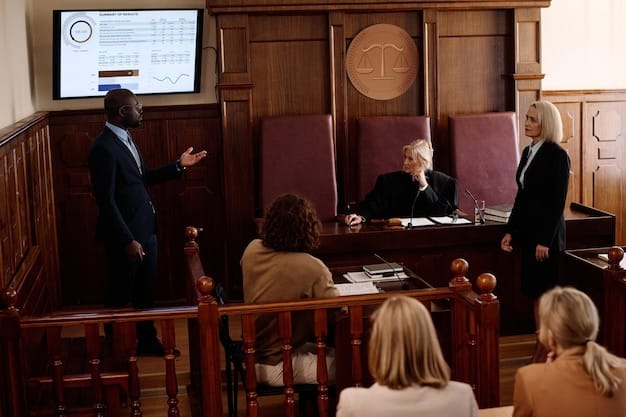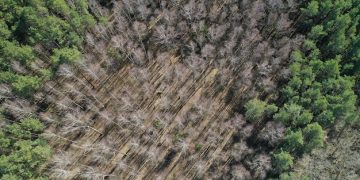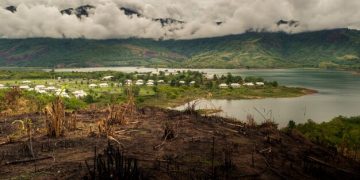US Climate Litigation: Latest Developments & Impact on Corporations

US climate litigation is rapidly evolving, with recent cases targeting corporate accountability for climate change impacts, potentially reshaping business practices and accelerating the transition to sustainable operations.
The landscape of US climate litigation is constantly shifting, with new cases emerging that aim to hold corporations accountable for their role in climate change. This article explores the latest developments in this area and examines how these legal challenges could significantly impact corporate behavior.
Understanding the Rise of Climate Litigation in the US
Climate litigation is an increasingly prominent strategy to address climate change in the United States. It involves bringing legal action against governments, companies, or other entities whose actions are believed to contribute to climate change or hinder efforts to mitigate its effects. Understanding the factors driving this rise is crucial.
Key Drivers of Climate Litigation
Several factors have contributed to the surge in climate-related lawsuits. Increased awareness of climate change impacts, advancements in climate science, and a perceived lack of governmental action have all fueled the trend.
- Legal scholars and environmental advocates have developed innovative legal strategies to address climate change.
- Growing scientific evidence linking specific corporate actions to climate change impacts strengthens plaintiffs’ cases.
- Frustration with the slow pace of policy changes at the federal level has pushed activists toward the courts.
Consequently, climate litigation has emerged as a tool to compel action on climate change from various actors.

Landmark Cases and Legal Precedents
Several landmark cases have shaped the landscape of climate litigation in the US, establishing important legal precedents and influencing future lawsuits. Examining these cases provides insights into the types of claims being made and the legal challenges involved.
Massachusetts v. EPA (2007)
This Supreme Court case established that the EPA has the authority to regulate greenhouse gases under the Clean Air Act. It paved the way for future regulations and lawsuits targeting emissions from various sources.
Juliana v. United States
Although not successful, this case brought by young plaintiffs argued that the government had a constitutional duty to protect them from the harms of climate change. It raised awareness about intergenerational equity and the government’s responsibility to address climate change.
Current Litigation Against Major Oil Companies
Numerous cities and states have filed lawsuits against major oil companies, seeking damages for the costs of adapting to climate change impacts like sea-level rise and extreme weather events. These cases allege that the companies knew about the risks of climate change but concealed this information from the public.
These landmark cases and ongoing lawsuits demonstrate the evolving legal strategies being used to address climate change and hold various entities accountable.
Recent Developments in Climate Litigation
The field of US climate litigation continues to evolve with several notable developments in recent years. These include new types of claims, shifts in legal strategies, and increased attention on corporate disclosures. Staying informed about these developments is essential to understanding the current state of climate litigation.
Focus on Corporate Disclosures
A growing number of lawsuits target companies for allegedly misleading investors about the risks of climate change. These cases often focus on companies’ disclosures related to climate-related financial risks, alleging that they failed to adequately warn investors about potential impacts on their businesses.
Increased Use of Public Nuisance Claims
Public nuisance claims, which allege that a defendant’s actions interfere with the public’s right to health, safety, or welfare, are being used more frequently in climate litigation. These claims seek to hold companies accountable for contributing to climate change impacts that harm the public.

These recent developments indicate a broadening scope of climate litigation and a greater emphasis on corporate accountability.
How Climate Litigation Impacts Corporate Behavior
Climate litigation has the potential to significantly impact corporate behavior by creating financial risks, reputational risks, and incentives to reduce greenhouse gas emissions. Companies are increasingly aware of these potential impacts and are taking steps to adapt.
Financial and Reputational Risks
Lawsuits can result in significant financial penalties for companies, including damages, fines, and legal fees. Additionally, climate litigation can damage a company’s reputation, leading to decreased sales, investor confidence, and brand value.
Incentives for Emissions Reductions
To mitigate the risk of future litigation, companies are increasingly incentivized to reduce their greenhouse gas emissions and invest in sustainable business practices. This may involve setting emissions reduction targets, transitioning to renewable energy sources, and implementing energy efficiency measures.
Moreover, Climate litigation encourages companies to be more transparent about their climate-related risks and impacts, fostering greater accountability.
Challenges and Obstacles in Climate Litigation
Despite its potential, climate litigation faces numerous challenges and obstacles. These include legal hurdles, scientific uncertainty, and political opposition. Addressing these challenges is crucial to the success of climate litigation.
Legal Hurdles
Plaintiffs in climate cases often face challenges in establishing causation, demonstrating that a defendant’s actions directly caused the harm they are claiming. Additionally, some courts may be reluctant to hear climate cases, citing issues of standing or political questions.
Scientific Uncertainty
While climate science is well-established, there is still uncertainty about the precise impacts of climate change at the local level. This uncertainty can make it difficult for plaintiffs to prove that a defendant’s actions caused specific harms.
Moreover, overcoming these challenges is essential for climate litigation to achieve its goals of holding entities accountable and compelling action on climate change.
The Future of Climate Litigation in the US
The future of climate litigation in the US is uncertain, but several trends suggest that it will continue to play a significant role in shaping climate policy and corporate behavior. These trends include the increasing sophistication of legal strategies, the growing involvement of institutional investors, and the potential for international coordination.
Increasing Sophistication of Legal Strategies
As climate litigation evolves, legal strategies are becoming more sophisticated. Lawyers are developing new theories of liability, using advanced scientific evidence, and targeting specific corporate actions more effectively.
Growing Involvement of Institutional Investors
Institutional investors, such as pension funds and asset managers, are increasingly using climate litigation to protect their investments from climate-related risks. They may file lawsuits against companies that fail to adequately disclose climate risks or that engage in activities that contribute to climate change.
These trends suggest that climate litigation will continue to be a dynamic and influential force in the years to come. It will likely shape the way companies approach climate change and influence the development of climate policy at all levels of government.
| Key Point | Brief Description |
|---|---|
| ⚖️ Rising Lawsuits | Increasing climate-related lawsuits in the US. |
| 🏢 Corporate Impact | Litigation can financially and reputationally impact corporations. |
| 🌱 Emission Cuts | Companies are cutting emissions to avoid litigation. |
| 🔮 Future Trends | Sophisticated legal strategies and investor involvement are growing. |
Frequently Asked Questions
▼
The primary goal is to hold entities accountable for their contribution to climate change and to compel them to reduce emissions or pay damages for climate-related harms.
▼
Typical defendants include major oil companies, governments, and other organizations whose actions are believed to contribute significantly to climate change.
▼
Challenges include establishing causation, overcoming the political question doctrine, and dealing with scientific uncertainty related to local climate impacts.
▼
Climate litigation can create financial and reputational risks for corporations, incentivizing emission reductions and greater transparency regarding climate-related risks.
▼
Future trends include increasing sophistication of legal strategies, growing involvement of institutional investors, and the potential for international coordination of climate lawsuits.
Conclusion
The evolving landscape of US climate litigation presents both challenges and opportunities for addressing climate change. As legal strategies become more refined and stakeholders become more engaged, climate litigation is poised to play a crucial role in shaping corporate behavior and accelerating the transition to a sustainable future.





